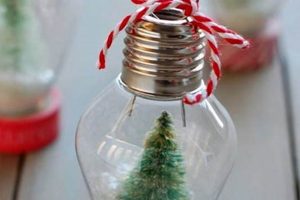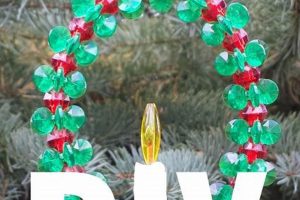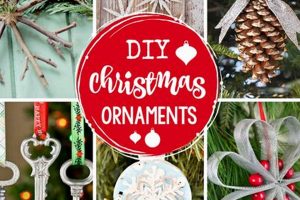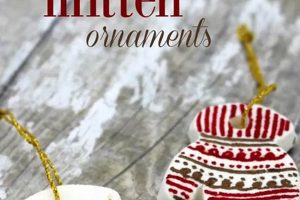The creation of decorative items through the application of beads, typically involving self-initiated projects, results in individualized festive adornments. For instance, individuals may construct a snowflake using wire as a frame, threading various sizes and colors of beads onto the wire to form the desired shape, culminating in a unique embellishment.
Handcrafted decorations offer a personalized alternative to mass-produced items, allowing for unique expression and creativity. The process fosters resourcefulness and can be a cost-effective method for generating distinctive holiday decorations, with historical precedent in various cultures where beading served both decorative and symbolic purposes.
The following sections detail specific techniques, material considerations, and design possibilities for producing customized beaded festive decorations. Exploration of various patterns, bead types, and construction methods will provide a comprehensive guide to creating individualized ornamental pieces.
Tips for Bead Ornament Creation
Successful execution of decorative beaded items requires careful planning and attention to detail. The following points offer guidance for optimizing the creation process and achieving desired aesthetic outcomes.
Tip 1: Material Selection: Choose beads based on desired aesthetic and structural integrity. Glass beads offer clarity and weight, while plastic beads provide lightweight affordability. Consistent sizing ensures uniform designs.
Tip 2: Wire Gauge Selection: Employ appropriate wire gauge for the chosen beads. Thicker wire provides structural support for larger, heavier beads, preventing breakage or deformation. Finer wire is suitable for intricate designs using smaller beads.
Tip 3: Pattern Planning: Develop a clear pattern prior to stringing beads. Consider color palettes, symmetry, and the overall desired shape. Sketching the design can minimize errors and optimize the final product.
Tip 4: Secure Fastenings: Employ secure fastening methods to prevent bead loss. Utilize crimp beads, knotting techniques, or wire wrapping to ensure beads remain affixed to the base material.
Tip 5: Tension Control: Maintain consistent tension during the stringing process. Overly tight tension can cause breakage, while insufficient tension results in loose or uneven structures. Practice ensures optimal bead placement.
Tip 6: Proper Tools: Employ specialized tools for effective creation. Needle-nose pliers assist in manipulating wire, while bead boards facilitate organization and design visualization. Precision tools improve accuracy.
Tip 7: Finishing Touches: Consider incorporating embellishments beyond beads. Ribbons, charms, or additional wirework can enhance the design and add visual interest. Judicious application elevates the finished product.
Adhering to these recommendations promotes structural soundness, aesthetic appeal, and overall quality in customized beaded holiday decorations. Thoughtful preparation enhances the decorative item’s visual impact and longevity.
The subsequent section will address methods for adapting these techniques to various decorative themes, providing further avenues for individualized creative expression.
1. Bead selection
Bead selection represents a critical initial phase in the creation of handcrafted beaded decorations. The properties of chosen beads directly influence the aesthetic, structural integrity, and overall success of the finished item. Therefore, a deliberate approach to bead selection is paramount.
- Material Composition
The material composition of beads (e.g., glass, plastic, wood, metal) dictates their weight, durability, and light refraction properties. Glass beads offer clarity and weight, suitable for intricate, high-quality ornaments. Plastic beads provide lightweight affordability for larger-scale or less structurally demanding projects. Material selection impacts the ornament’s final appearance and longevity.
- Size and Shape Consistency
Uniformity in bead size and shape is essential for symmetrical and aesthetically balanced designs. Inconsistent bead dimensions can lead to uneven surfaces and structural instability. Precision-cut beads are particularly important for complex patterns requiring precise alignment. Deviation from uniformity may introduce undesired visual disruptions.
- Color and Finish
Color palettes and bead finishes (e.g., opaque, iridescent, metallic) significantly impact the ornament’s visual impact. Harmonious color combinations and complementary finishes enhance aesthetic appeal. Consideration of ambient lighting conditions is necessary, as certain finishes interact differently with light, altering the perceived color. Strategic color selection evokes specific themes and moods.
- Hole Size and Configuration
Bead hole size must correspond appropriately with the chosen stringing material (e.g., wire gauge, thread thickness). Insufficient hole size obstructs stringing, while excessive hole size compromises the security and stability of the ornament. The hole’s configuration (e.g., centered, off-center) also affects bead alignment and overall design cohesion.
Effective bead selection, therefore, involves a holistic assessment of material properties, dimensional consistency, aesthetic attributes, and functional compatibility. Optimal choices contribute directly to the creation of visually appealing, structurally sound, and enduring handcrafted beaded holiday decorations. Neglecting these considerations can lead to compromised aesthetics and reduced durability.
2. Design planning
Design planning forms a critical pre-execution stage in crafting customized beaded festive decorations. It establishes the conceptual framework and technical specifications that guide the creation process, ensuring a cohesive and aesthetically pleasing final product. The absence of comprehensive design planning frequently results in disjointed or structurally unsound decorative items.
- Conceptualization and Thematic Cohesion
Design planning initiates with the conceptualization of the ornament’s theme and overall aesthetic. This involves selecting a central motif (e.g., snowflake, star, animal figure) and establishing a consistent visual vocabulary. Thematic cohesion dictates the selection of appropriate bead colors, shapes, and sizes, ensuring that all design elements harmonize to create a unified and recognizable representation. For instance, a nautical-themed ornament may incorporate blue, white, and silver beads, along with shell-shaped accents, to evoke a maritime aesthetic.
- Pattern Development and Symmetry Considerations
Following conceptualization, pattern development entails the creation of a detailed arrangement of beads, often involving symmetrical or repeating sequences. Symmetrical patterns offer visual balance and stability, while asymmetrical designs introduce dynamism and visual interest. Accurate pattern planning is crucial for maintaining structural integrity and preventing design flaws. Complex patterns require precise measurements and careful bead placement to achieve the desired visual effect.
- Material Inventory and Resource Allocation
Design planning necessitates a thorough assessment of required materials, including bead quantities, wire gauge, and fastening components. This involves calculating the necessary resources and ensuring their availability prior to initiating the construction process. Accurate material inventory minimizes disruptions and prevents project delays. Efficient resource allocation optimizes material usage and reduces waste.
- Structural Analysis and Feasibility Assessment
Prior to execution, design planning incorporates a structural analysis to assess the feasibility and stability of the proposed ornament design. This involves evaluating potential stress points and identifying areas that require reinforcement. Adjustments to the design may be necessary to ensure the ornament’s structural integrity and prevent breakage or deformation under its own weight. A feasibility assessment verifies that the design is technically viable and can be executed within the available skill set and resource constraints.
These facets of design planning conceptualization, pattern development, material inventory, and structural analysis synergistically contribute to the successful fabrication of customized beaded holiday decorations. By meticulously addressing these considerations, creators can ensure that their ornaments possess both aesthetic appeal and structural durability. A well-defined design plan serves as a roadmap for the entire crafting process, optimizing resource allocation and minimizing potential errors, resulting in a refined and enduring decorative item.
3. Structural Integrity
Within the domain of handcrafted beaded festive decorations, structural integrity denotes the capacity of an item to withstand external forces and maintain its intended shape and composition over an extended period. This characteristic is of paramount importance; without it, the aesthetic value and functional utility of a beaded ornament are severely compromised. The selection of materials, the techniques employed in stringing and fastening, and the overall design significantly influence structural integrity. For example, using brittle wire for a heavy, multi-layered bead ornament will inevitably lead to breakage, illustrating a direct cause-and-effect relationship between material choice and structural failure.
Structural integrity in bead ornaments diy manifests in several practical applications. Accurate wire gauge selection prevents deformation or snapping under the weight of the beads. Secure fastening methods, such as crimping or knotting, are essential to prevent bead displacement and maintain the intended pattern. Designs incorporating complex geometric shapes require a strong internal framework to distribute stress evenly. Furthermore, environmental factors such as temperature and humidity can affect the longevity of certain materials, underscoring the need for material selection that accounts for these variables. Consider ornaments made with cheap plastic beads which can crack or turn yellow when exposed to light. All of these considerations underscore the importance of structural integrity.
In conclusion, structural integrity is a foundational element in beaded ornament creation. It ensures that the ornament not only possesses visual appeal but also exhibits the robustness necessary to endure handling and environmental exposure. The challenges in achieving optimal structural integrity often lie in balancing aesthetic considerations with engineering principles, requiring a nuanced understanding of materials science and construction techniques. The ability to create durable, visually appealing beaded ornaments relies significantly on the recognition and prioritization of structural integrity as a core design criterion.
4. Color palettes
Color palettes constitute a fundamental aspect of “bead ornaments diy,” influencing the aesthetic appeal and thematic representation of the finished product. Color choice directly affects the ornament’s visual impact, dictating its ability to evoke specific emotions, convey particular themes, or complement existing decorative schemes. The selection of an inappropriate color palette can detract from the ornament’s design, undermining its intended purpose. For instance, a haphazard combination of clashing hues may result in a visually jarring ornament that fails to integrate cohesively within a holiday display. A well-considered palette, conversely, enhances the ornament’s visual harmony, imbuing it with sophistication and elegance.
The practical applications of understanding color palettes in crafting beaded ornaments extend to thematic representation and customization. A color palette comprising red, green, and gold beads traditionally signifies a Christmas theme, evoking feelings of warmth and festivity. Alternatively, a palette of silver, blue, and white can establish a winter wonderland aesthetic. Personalization is also a key benefit. Understanding color theory enables creators to tailor ornaments to individual preferences or to match specific color schemes within a room or display, increasing the ornament’s aesthetic integration. Knowledge of color interactions, such as complementary and analogous color schemes, facilitates more sophisticated and visually engaging ornament designs.
Effective color palette selection represents a challenge that requires both an understanding of color theory and an appreciation for aesthetic principles. The deliberate manipulation of color contributes significantly to the perceived quality and visual impact of handcrafted beaded ornaments. By carefully considering the implications of color choices, creators can elevate their designs, crafting ornaments that are not only aesthetically pleasing but also meaningfully expressive.
5. Stringing techniques
Stringing techniques constitute a critical component within the domain of “bead ornaments diy,” directly influencing the structural integrity, aesthetic appeal, and overall durability of the finished decorative item. The method by which beads are affixed to a substrate, typically wire or thread, determines the ornament’s resistance to stress and its ability to maintain its intended form over time. Inadequate stringing techniques frequently result in bead displacement, pattern distortion, and ultimately, structural failure of the ornament. For example, employing a simple, unsecured stringing method for a complex, multi-layered beaded snowflake will inevitably lead to the unraveling of the design and the loss of individual beads, demonstrating the direct correlation between technique and outcome.
The practical applications of diverse stringing techniques extend to various design considerations. The selection of a specific technique should align with the size, shape, and material of the beads, as well as the complexity of the intended design. For instance, weaving techniques, involving intricate interlinking of beads, provide enhanced structural stability for geometrically complex ornaments. In contrast, simpler stringing methods may suffice for basic designs featuring larger, more robust beads. The choice of stringing material, whether wire, thread, or monofilament, also dictates the appropriate technique. Wire-based stringing often necessitates the use of specialized tools, such as crimping pliers, to secure beads and prevent slippage. Thread-based stringing relies on knotting techniques to achieve similar results. These choices reflect the versatility required in beading.
In summary, stringing techniques are a fundamental element in “bead ornaments diy.” The selection and execution of appropriate techniques are paramount to achieving visually appealing and structurally sound decorative items. The challenges in mastering stringing techniques often lie in balancing aesthetic considerations with engineering principles, requiring a nuanced understanding of material properties and construction methods. The ability to create enduring, visually appealing beaded ornaments relies significantly on the recognition and prioritization of skillful stringing as a core design criterion.
6. Fastening methods
Fastening methods represent a crucial aspect of “bead ornaments diy,” determining the longevity and structural integrity of the finished product. The effectiveness of these methods directly impacts the ornament’s ability to withstand handling, environmental factors, and the weight of its constituent beads. Inadequate fastening invariably leads to bead displacement, design disintegration, and premature ornament failure. Consider, for example, a beaded star ornament where the wire ends are merely twisted together instead of securely crimped; the twisting action, over time and with handling, loosens and the ornament unravels, causing bead loss and shape distortion.
Appropriate fastening techniques vary depending on the materials used, the ornament’s design complexity, and the intended use. Wire-based constructions typically utilize crimp beads, wire wrapping, or soldering to secure the beads in place. Crimp beads, when properly compressed with specialized pliers, provide a reliable and unobtrusive fastening point. Wire wrapping involves creating loops or spirals around the ends of the wire, mechanically securing the beads and adding a decorative element. Soldering offers the strongest bond but requires specialized equipment and skill. For thread-based projects, knotting techniques, such as overhand knots, square knots, or surgeon’s knots, are employed to prevent slippage. The choice of knot depends on the thread material and the size of the bead holes. Securing the end of the knot with a small amount of adhesive enhances its durability. Understanding and properly applying these methods is crucial for the end product success. A failure in even one of the fastening points weakens the structure.
In conclusion, appropriate fastening methods are integral to the success of “bead ornaments diy.” They ensure the ornament’s structural stability, prolong its lifespan, and preserve its aesthetic qualities. The careful selection and execution of appropriate fastening techniques, tailored to the specific materials and design, are paramount to creating enduring and visually appealing handcrafted beaded holiday decorations. The durability and the ornament’s beauty are inextricably linked through the quality of its fastening.
7. Tool usage
Proficient tool usage is integral to achieving precision, efficiency, and structural integrity in handcrafted beaded festive decorations. Appropriate tools facilitate intricate designs, secure fastenings, and a professional finish, underscoring their significance in the creation process.
- Needle-Nose Pliers
Needle-nose pliers are essential for manipulating wire, forming loops, and securing crimp beads in “bead ornaments diy.” These pliers provide a precise grip, enabling the creation of intricate wirework patterns and the secure fastening of beads, preventing slippage and ensuring structural stability. For example, forming a tight, even loop at the end of a wire stem requires the fine control afforded by needle-nose pliers, influencing the overall aesthetic and durability.
- Wire Cutters
Wire cutters are indispensable for cleanly severing wire to the desired length in “bead ornaments diy.” A clean cut prevents frayed ends that can snag or pose a safety hazard. Appropriate wire cutters, designed for specific wire gauges, ensure precise and efficient cutting, contributing to a professional finish. Using dull or unsuitable cutters can deform the wire, hindering the stringing process and compromising the ornament’s structural integrity.
- Bead Boards
Bead boards provide a structured surface for organizing beads and planning ornament designs in “bead ornaments diy.” These boards feature recessed channels and compartments that prevent beads from rolling away, facilitating efficient design layout. They also allow for pre-visualization of the pattern before stringing, reducing errors and optimizing material usage. Utilizing a bead board streamlines the design process and contributes to a more organized and efficient workflow.
- Crimpers
Crimpers are specialized pliers designed to securely compress crimp beads, affixing beads to wire in “bead ornaments diy.” Proper crimping ensures a strong and durable connection, preventing bead slippage and maintaining the structural integrity of the ornament. Incorrect crimping, using inappropriate tools or techniques, can weaken the connection, leading to premature failure. A well-crimped bead provides a visually discreet and structurally sound fastening point.
The effective integration of these tools enhances the quality, precision, and efficiency of handcrafted beaded festive decorations. Proper tool selection and usage contribute directly to the visual appeal, structural integrity, and overall longevity of the finished product, emphasizing the symbiotic relationship between tool proficiency and successful “bead ornaments diy.” The absence of suitable tools and the requisite skills can significantly compromise the final outcome.
Frequently Asked Questions about Bead Ornaments diy
This section addresses common inquiries regarding the creation of decorative beaded ornaments, providing clarity on materials, techniques, and troubleshooting.
Question 1: What bead types are most suitable for durable ornament construction?
Glass beads generally offer superior durability and weight, ideal for intricate, long-lasting ornaments. Plastic beads provide a cost-effective and lightweight alternative, suitable for less structurally demanding designs. The selection should align with the intended ornament’s complexity and expected longevity.
Question 2: What wire gauge is recommended for supporting various bead weights?
Thicker wire gauges (e.g., 20-22 gauge) are recommended for supporting heavier beads, preventing bending or breakage. Finer gauges (e.g., 26-28 gauge) are suitable for lighter beads and intricate wirework. The chosen gauge should correspond with the bead weight and the complexity of the design to ensure structural integrity.
Question 3: How can bead slippage be effectively prevented in beaded ornaments?
Employing secure fastening methods such as crimping or wire wrapping is essential to prevent bead slippage. Crimp beads, when properly compressed, provide a reliable anchor. Knotting techniques are suitable for thread-based designs. Consistent tension during stringing minimizes the risk of bead displacement.
Question 4: What tools are necessary for efficient and precise ornament creation?
Needle-nose pliers facilitate intricate wirework and secure crimping. Wire cutters provide clean and precise wire severing. Bead boards aid in design planning and bead organization. Crimpers ensure secure and reliable crimp bead compression. These tools enhance precision and efficiency.
Question 5: How can color palettes be effectively utilized to enhance the aesthetic appeal of ornaments?
Harmonious color combinations, such as complementary or analogous color schemes, enhance visual appeal. Consideration of ambient lighting conditions and thematic representation is crucial. Strategic color selection evokes specific moods and complements existing decorative schemes.
Question 6: What strategies can be employed to ensure the structural integrity of complex ornament designs?
Reinforced wire frameworks provide support for intricate designs. Secure fastening techniques at all connection points are crucial. Distributing weight evenly across the structure minimizes stress points. Structural analysis during design planning helps identify potential weaknesses.
These FAQs provide a comprehensive overview of key considerations in “bead ornaments diy.” Adherence to these guidelines promotes visually appealing and structurally sound handcrafted decorative items.
The following section will explore specific ornament design tutorials.
Conclusion
The preceding sections have detailed fundamental aspects of handcrafted decorative beaded items. These aspects encompass material selection, design considerations, construction techniques, and structural integrity imperatives. The skillful application of these concepts determines the durability, aesthetic appeal, and overall success of “bead ornaments diy” endeavors. Comprehensive understanding mitigates common errors and enhances the quality of the resulting ornamentation.
Continued exploration of advanced techniques, combined with meticulous execution, remains essential for refining craft and fostering creative expression within the sphere of beaded ornament construction. A sustained commitment to innovation will drive future advancements in material usage and structural design, expanding the possibilities within this craft.







